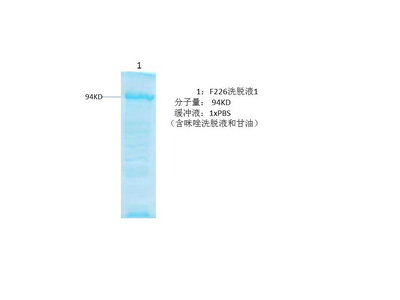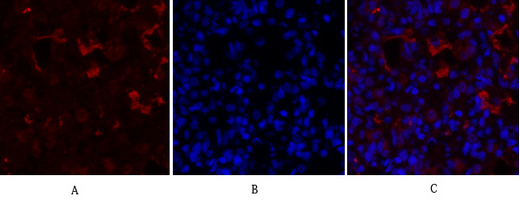PPAR gamma protein
- Catalog No.:YD0087
- Applications:WB;SDS-PAGE
- Reactivity:Human
- Gene Name:
- PPARG
- Protein Name:
- PPAR gamma protein
- Sequence:
- Amino acid: 4-306, with his-MBP tag.
- Human Gene Id:
- 5468
- Human Swiss Prot No:
- P37231
- Mouse Swiss Prot No:
- P37238
- Formulation:
- Liquid in PBS
- Concentration:
- SDS-PAGE >90%
- Storage Stability:
- -20°C/6 month,-80°C for long storage
- Other Name:
- Peroxisome proliferator-activated receptor gamma (PPAR-gamma) (Nuclear receptor subfamily 1 group C member 3)
- Background:
- alternative products:Additional isoforms seem to exist,disease:Defects in PPARG are the cause of familial partial lipodystrophy type 3 (FPLD3) [MIM:604367]. Familial partial lipodystrophies (FPLD) are a heterogeneous group of genetic disorders characterized by marked loss of subcutaneous (sc) fat from the extremities. Affected individuals show an increased preponderance of insulin resistance, diabetes mellitus and dyslipidemia.,disease:Defects in PPARG can lead to type 2 insulin-resistant diabetes and hyptertension.,disease:Defects in PPARG may be associated with colon cancer.,disease:Defects in PPARG may be associated with susceptibility to obesity [MIM:601665].,disease:Variation in PPARG is associated with carotid intimal medial thickness 1 (CIMT1) [MIM:609338]. CIMT is a measure of atherosclerosis that is independently associated with traditional atherosclerotic cardiovascular disease risk factors and coronary atherosclerotic burden. 35 to 45% of the variability in multivariable-adjusted CIMT is explained by genetic factors.,function:Receptor that binds peroxisome proliferators such as hypolipidemic drugs and fatty acids. Once activated by a ligand, the receptor binds to a promoter element in the gene for acyl-CoA oxidase and activates its transcription. It therefore controls the peroxisomal beta-oxidation pathway of fatty acids. Key regulator of adipocyte differentiation and glucose homeostasis.,online information:Peroxisome proliferator-activated receptor entry,online information:The Singapore human mutation and polymorphism database,polymorphism:Genetic variation in PPARG may influence body mass index (BMI) [MIM:606641]. BMI reflects the amount of fat, lean mass, and body build.,similarity:Belongs to the nuclear hormone receptor family.,similarity:Belongs to the nuclear hormone receptor family. NR1 subfamily.,similarity:Contains 1 nuclear receptor DNA-binding domain.,subunit:Forms a heterodimer with the retinoic acid receptor RXRA called adipocyte-specific transcription factor ARF6. Interacts with NCOA6 coactivator, leading to a strong increase in transcription of target genes. Interacts with coactivator PPARBP, leading to a mild increase in transcription of target genes. Interacts with FAM120B (By similarity). Interacts with NOCA7 in a ligand-inducible manner. Interacts with NCOA1 LXXLL motifs. Interacts with TGFB1I1. Interacts with DNTTIP2.,tissue specificity:Highest expression in adipose tissue. Lower in skeletal muscle, spleen, heart and liver. Also detectable in placenta, lung and ovary.,
- Function:
- negative regulation of transcription from RNA polymerase II promoter, regulation of cell growth, regulation of cytokine production, negative regulation of cytokine production, placenta development, immune system development,leukocyte differentiation, myeloid leukocyte differentiation, regulation of acute inflammatory response, negative regulation of acute inflammatory response, circulatory system process, transcription, regulation of transcription, DNA-dependent, regulation of transcription from RNA polymerase II promoter, lipid transport, defense response, immune response, response to nutrient, blood circulation, protein localization, regulation of blood pressure, negative regulation of cell proliferation, regulation of cell size, response to temperature stimulus, response to cold, response to abiotic stimulus, response to endogenous stimulus, response to hormone stimulus, negative regu
- Subcellular Location:
- Nucleus. Cytoplasm. Redistributed from the nucleus to the cytosol through a MAP2K1/MEK1-dependent manner. NOCT enhances its nuclear translocation.
- Expression:
- Highest expression in adipose tissue. Lower in skeletal muscle, spleen, heart and liver. Also detectable in placenta, lung and ovary.
- June 19-2018
- WESTERN IMMUNOBLOTTING PROTOCOL
- June 19-2018
- IMMUNOHISTOCHEMISTRY-PARAFFIN PROTOCOL
- June 19-2018
- IMMUNOFLUORESCENCE PROTOCOL
- September 08-2020
- FLOW-CYTOMEYRT-PROTOCOL
- May 20-2022
- Cell-Based ELISA│解您多样本WB检测之困扰
- July 13-2018
- CELL-BASED-ELISA-PROTOCOL-FOR-ACETYL-PROTEIN
- July 13-2018
- CELL-BASED-ELISA-PROTOCOL-FOR-PHOSPHO-PROTEIN
- July 13-2018
- Antibody-FAQs
- Products Images



